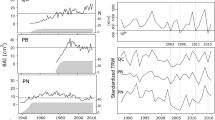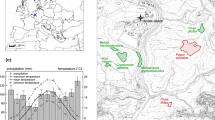Abstract
Using a representative sample of stands from a cross section through the Bavarian portion of the northern Calcareous Alps, this study evaluates the plausibility and significance of causal hypotheses for an explanation of the poor crown condition of Norway spruce in mountain forests: (1) ozone exposure in conjunction with (a) drought and (b) ample water supply; (2) soil-borne nutrient deficiency; (3) drought; and (4) tree age. Site index and, in a subset of stands, foliar nutrient concentrations are considered as additional indicators of tree vigour. According to principal component analysis and multiple regression, crown condition was controlled by soil chemistry (transparency increased towards shallow calcareous soils), stand age and, to a smaller degree, by an interaction between ozone exposure and drought. Site index was best explained by a model including elevation, soil chemistry and drought. Tree nutrition clearly reflected the main soil chemical gradient, and P, N and Fe deficiencies were found in transparent stands, which had markedly smaller needles. The similar distributions of crown transparency, site index and nutrition present a strong argument for the hypothesis that soil chemistry has constrained the vigour of spruce trees in the Calcareous Alps for a long time. By leaving unproductive stands to age naturally, forest management has accentuated the pattern of crown condition. In the heterogeneous alpine landscape, possible effects of recent increases in ozone exposure have to be viewed extremely carefully against the background of these natural and anthropogenic covariables.



Similar content being viewed by others
References
Anonymous (1983) Geologische Übersichtskarte 1:200 000, Blatt CC 8726 Kempten (Allgäu). Bundesanstalt für Geowissenschaften, Hannover
Anonymous (1996a) Klimaatlas von Bayern. Bayerischer Klimaforschungsverbund, München
Anonymous (1996b) Forstliche Standortsaufnahme, 5th edn. IHW, Eching
Anonymous (1997) Waldzustandsbericht 1997. Bayerische Landesanstalt für Wald und Forstwirtschaft, Freising
Anonymous (1999) SPSS für Windows Release 9.0.1 (11 Mar 1999). SPSS Inc.
Beers TW, Dress PE, Wensel LC (1966) Aspect transformation in site productivity research. J For 64:691–692
Bosch C (1986) Standorts- und ernährungskundliche Untersuchungen zu den Erkrankungen der Fichte (Picea abies [L.] Karst.) in höheren Gebirgslagen. Forstliche Forschungsberichte 75, München
Dobbertin M (1996) Relationship beween basal area increment, tree crown defoliation and tree and site variables. In: Proceedings of the IUFRO Conference on Effects of environmental factors on tree and stand growth, Berggieshüber/Dresden, Technische Universität Dresden, Dresden, pp 33–44
Dobson MC, Taylor G, Freer-Smith PH (1990) The control of ozone uptake by Picea abies (L.) Karst and Picea sitchensis (Bong.) Carr. during drought and interacting effects on shoot water relations. New Phytol 116:465–474
Ellenberg H (1995) Allgemeines Waldsterben—ein Konstrukt? Bedenken eines Ökologen gegen Methoden der Schadenserfassung. Naturwiss Rundsch 48:93–96
Ewald J (1997) Die Bergmischwälder der Bayerischen Alpen—Soziologie, Standortbindung und Verbreitung. Dissertation bot 290, Cramer, Berlin
Ewald J (1999) Soziologie und Standortbindung subalpiner Fichtenwälder in den Bayerischen Alpen. Tuexenia 19:107–125
Ewald J, Reuther M (1999) Gradienten von Vegetation und Standort und ihre Beziehungen zum Kronenzustand von Bergwäldern in den Bayerischen Alpen. Verh Ges Ökol 29:39–52
Ewald J, Reuther M, Nechwatal J, Lang K (2000) Monitoring von Schäden in Waldökosystemen des bayerischen Alpenraumes. Materialien 155, Bayerisches Staatsministerium für Landesentwicklung u. Umweltfragen, München
Flückiger W, Braun S (1995) Revitalization of an alpine protective forest by fertilization. Plant Soil 168:481–488
Franz F, Preuhsler T, Röhle H (1987) Vitalitätsmerkmale und Zuwachsreaktionen erkrankter Bergwaldbestände im Bayerischen Alpenraum. Allg Forstz 41:962–964
Freyer K (1986) Forstliche Standortskartierung im Hochgebirge. Allg Forstztg 39:967–969
Gulder H-J, Kölbel M (1993) Waldbodeninventur in Bayern. Forstliche Forschungsberichte, München, p 132
Haupolter M (1999) Zustand von Bergwäldern in den nördlichen Kalkalpen Tirols und daraus ableitbare Empfehlungen für eine nachhaltige Bewirtschaftung. Diss, University of Bodenkultur, Wien
Hüttl RF (1991) Die Nährelementversorgung geschädigter Wälder in Europa und Nordamerika. Freiburger Bodenkundl Abhandlungen, Freiburg, p 28
Kennel E (1990) Übersicht über neuartige Schäden im Bergwald und zeitliche Entwicklung. Forstwiss Forsch 40:66–79
Klap J, Voshaar JO, de Vries W, Erisman JW (1997) Relationship between crown condition and stress factors. In: Anonymous (ed) Ten years of monitoring forest condition in Europe. UN/ECE, Brussels, pp 277–307
Lang H (1991) Die abhängigkeit des Wachstums der Fichte von standortskundlichen Parametern im Nationalpark Berchtesgaden. Diploma Thesis, LMU München, München
Liu JC, Payer HD (1995) Ernährungszustand der Fichten am Wank. GSF-Bericht 18/(95):7–16
Liu JC, Payer HD (1996) AOT doses of ambient ozone accelerate green needle losses in an alpine stand of Norway spruce. In: Kärenlämpi L, Skärby L (eds) Critical levels for ozone in Europe. UN-ECE Workshop Report, Kuoipo, pp 249–255
Maier-Maercker U, Koch W (1991) Experiments on the control capacity of stomata of Picea abies (L.) Karst. after fumignation with ozone and in environmentally damaged material. Plant Cell Environ 14:175–184
Maier-Maercker U, Koch W (1995) Poor stomatal control of water balance and the abscission of green needles from a declining stand of spruce trees [Picea abies (L.) Karst.] from the northern Alps. Trees 10:63–73
Matyssek R, Havranek WM, Wieser G, Innes JL (1997) Ozone and the forests in Austria and Switzerland. In: Sandermann H et al (eds) Forest decline and ozone. Ecological studies vol 127. Springer, Berlin Heidelberg New York, pp 95–134
Paffrath D, Peters W (1988) Betrachtung der Ozonverteilung im Zusammenhang mit neuartigen Waldschäden. Forstwiss Centralbl 107:152–159
Polle A, Mössnang M, von Schönborn A, Sladkovic R, Rennenberg H (1992) Field studies on Norway spruce trees at high altitudes. I. Mineral, pigment and soluble protein contents of needles as affected by climate and pollution. New Phytol 121:89–99
Rehfuess K-E (1995) Gefährdung der Wälder in Mitteleuropa durch Luftschadstoffe und Möglichkeiten der Revitalisierung durch Düngung. Ber Reinhold-Tüxen-Ges 7:141–156
Thomsen MG, Nellemann C (1994) Isolation of natural factors affecting crown density and crown color in coniferous forest: implications for monitoring of forest decline. Ambio 23:251–254
Vacik H, Lexer MJ (1998) Indentifizierung von Standorts—und Bestandesmerkmalen auf die Kronenverlichtung von Picea abies (L.) Karst. als Grundlage waldbaulicher Planung. Forstarchiv 69:27–34
Walentowski H, Gulder H-J, Kölling C, Ewald J, Türk W (2001) Die regionale natürliche Waldzusammensetzung Bayerns. Berichte aus der Bayerischen Landesanstalt für Wald und Forstwirtschaft, Freising, p 32
Webster R, Rigling A, Walthert L (1996) An analysis of tree crown condition in relation to environment in Switzerland. Forestry 4:347–355
Whittaker J (1984) Model interpretation from the additive elements of the likelihood function. Appl Stat 33:52–64
Zech W (1969) Besonderheiten im Ernährungszustand chlorotischer Fichten auf kalkreichen Böden. Forstwiss Centralbl 88:1–9
Acknowledgements
I am grateful to the Bavarian Ministry of Land Development and the Environment for funding this research and to the Bavarian State Forest Administration for providing access to forest inventory data and for training surveying teams. I also appreciate the contributions of Karl-Eugen Rehfuess, Markus Reuther, Andreas Vogel, Ariane Schaub, Rita Heibl, Michael Englschall and Ilse Süß.
Author information
Authors and Affiliations
Corresponding author
Rights and permissions
About this article
Cite this article
Ewald, J. Ecological background of crown condition, growth and nutritional status of Picea abies (L.) Karst. in the Bavarian Alps. Eur J Forest Res 124, 9–18 (2005). https://doi.org/10.1007/s10342-004-0051-5
Received:
Accepted:
Published:
Issue Date:
DOI: https://doi.org/10.1007/s10342-004-0051-5




